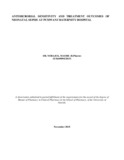| dc.contributor.author | Maore, Norah K | |
| dc.date.accessioned | 2016-04-21T12:23:59Z | |
| dc.date.available | 2016-04-21T12:23:59Z | |
| dc.date.issued | 2015 | |
| dc.identifier.uri | http://hdl.handle.net/11295/94630 | |
| dc.description.abstract | BACKGROUND: Neonatal sepsis is one of the most common causes of mortality and morbidity among infants in the developing countries. The spectrum and antimicrobial sensitivity patterns of bacteria responsible for neonatal sepsis could vary in different hospitals and regions. A periodic survey of the etiological agents and their susceptibility pattern is indeed necessary for the timely detection of the changing trend of antibiotic resistance. This will guide initial empirical choice of antimicrobial therapy in absence of culture and sensitivity results. This research focused on the sensitivity patterns of bacteria responsible for neonatal sepsis to antimicrobial agents used to treat neonatal sepsis. OBJECTIVE: To identify bacteria in blood cultures of neonates with clinically suspected septicemia, their susceptibility to commonly used antimicrobial agents and the treatment outcomes of neonatal sepsis. STUDY METHODOLOGY: A longitudinal design was used and the target population was all neonates born in the hospital or admitted to Pumwani Maternity Hospital with suspected sepsis. A sample size of 150 neonates with suspected sepsis was reached using consecutive sampling. Data was collected using a questionnaire and blood cultures were analyzed at Pediatric Department Laboratory, School of Medicine at the University of Nairobi. The statistical analysis was done using a software SPSS version 21.0. Data was expressed as mean +/- Standard Deviation, and comparison of proportions was performed using Exact Fisher‘s test and Chi-square. The significance level was set at p= ≤ 0.05. A bivariable analysis was done for all the variables used for the comparison of the neonates included in the study in relation to the outcomes. The key outcomes considered were length of inpatient treatment, culture positivity, and death.
RESULTS: Out of 150 blood specimens cultured, the prevalence of confirmed bacterial sepsis was 32% (48/150). Gram positive pathogens were predominant with isolates of Staphylococcus aureus and Streptococcus viridans accounting for 70% of the total isolates. Gram negative bacteria comprised of 18% of the total isolates with E.coli and Klebsiella spp being the only isolates. Staphylococcus aureus was the main pathogen in early onset sepsis while in late onset sepsis, 2 isolates were obtained that included Staphylococcus aureus and Streptococci
xv
pneumoniae. All the isolates were absolutely sensitive to meropenem. Staphylococcus aureus showed a high resistance to piperacillin (40%) and amoxicillin clavulanic acid (57%). All Gram positive isolates showed high sensitivity (above 80%) to gentamicin, ceftriaxone, ofloxacin and amikacin, except for Coagulase negative Staphylococcus aureus that showed 100% resistance to ofloxacin. The Gram negative pathogens exhibited a high resistance to ampicillin and some resistance to amikacin but a good sensitivity to gentamicin both at above 80%.The most common regimen prescribed is benzylpenicillin and gentamicin. Bacterial sepsis was higher in neonates with hyperthermia (p=0.003), vomiting (p=0.034) and respiratory distress. Male sex (p=0.018) and premature rupture of membranes (p=0.049) were predictors of positive blood culture. The overall death rate was 3.3% (5/150). CONCLUSIONS: Staphylococcus aureus predominates the etiology of neonatal septicaemia followed by E.coli. There was high resistance to ampicillin and amoxicillin clavulanic acid. Routine antimicrobial surveillance should be done to identify the trend of the causative agents along with their susceptibility patterns so as to guide the choice of antibiotics for empirical treatment of neonatal sepsis. | en_US |
| dc.language.iso | en | en_US |
| dc.publisher | University of Nairobi | en_US |
| dc.subject | Antimicrobial sensitivity and treatment outcomes of neonatal sepsis | en_US |
| dc.title | Antimicrobial sensitivity and treatment outcomes of neonatal sepsis at pumwani maternity hospital | en_US |
| dc.type | Thesis | en_US |
| dc.description.department | a
Department of Psychiatry, University of Nairobi, ; bDepartment of Mental Health, School of Medicine,
Moi University, Eldoret, Kenya | |

